When you write a call, you sell someone the right to buy an underlying stock from you at a strike price that’s specified by the option series. As the writer, you are now short the option. The buyer of your call is long the option. You also are obligated to deliver the stock if the buyer decides to exercise the call option.
As a call writer, you are hoping that
The stock goes nowhere.
You collect the premium.
The option expires worthless so you don’t have to come up with a hundred shares of the stock to settle when the holder exercises the call, which is what can happen with naked call writing.
When you write a naked call option, you’re selling someone else a chance to bet that the underlying stock is going to go higher in price. The catch is that you don’t own the stock, so if the buyer exercises the option, you need to buy the stock at the market price to meet your obligation. When you write a covered call option, you already own the shares. If you’re exercised against, you just sell your shares at the strike price.
Covered call writing is a perfect strategy if you’re looking to smooth out your portfolio’s performance and collect the extra income from the call premiums. When the call expires worthless, you get to keep the stock (which you already own) and collect all the dividends that accrued during the time the call was in play. When you write naked calls (in which you don’t own the stock), if the call expires worthless, you still keep the premium.






